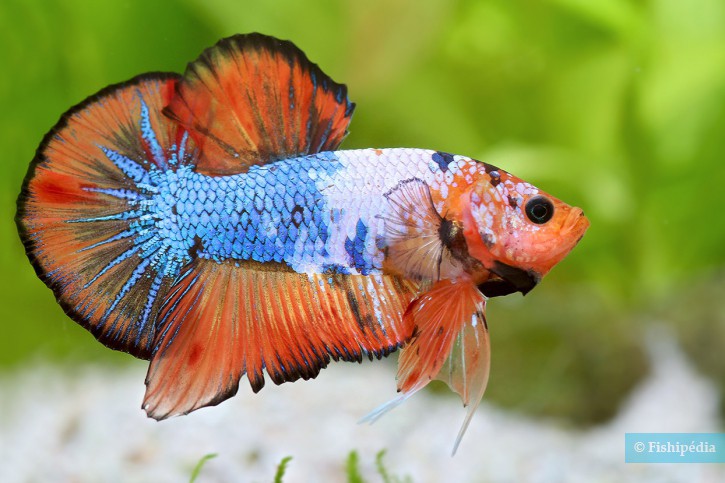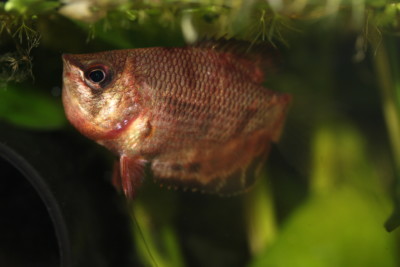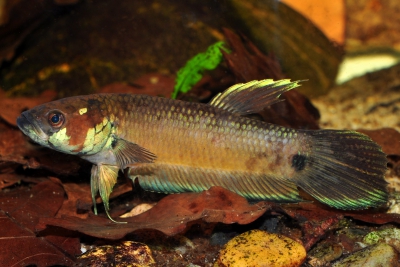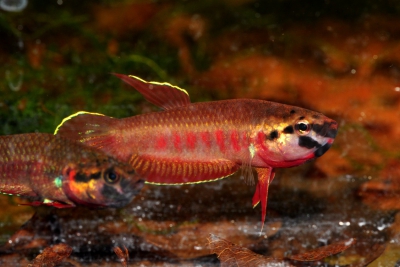Siamese fighting fish
| Scientific name | Betta splendens |
|---|---|
| Descriptor | Regan |
| Year of description | 1910 |
| IUCN category (World) | VU |
| Family | Osphronemidae |
| Genus | Betta |


Introduction
The Siamese fighting fish, Betta splendens, is a tropical fish native to Southeast Asia. It inhabits shallow areas of rice paddies and streams. Despite being the most popular species in the aquarium hobby after the goldfish, its wild populations are currently threatened by habitat degradation.
Who is it?
Morphology
-
Average size4 cm
-
Maximum size5 cm
-
Longevity5 year
-
ShapeRectangular
-
Average size4 cm
-
Maximum size5 cm
-
Longevity5 year
-
ShapeRectangular
How to recognize This fish ?
Like all fish of its genus, the Siamese fighting fish has the particularity of being able to breathe in two different ways. In addition to the classic gills, this species is equipped with a breathing apparatus called Labyrinthe which allows it to absorb oxygen from the air. These species are commonly called the labyrinth Fish.
The Siamese fighting fish is known to aquarium enthusiasts for the diversity of its shimmering-colored coats. In commerce, selected varieties can be solid-colored, two-colored, or multicolored. There are varieties for almost every color, although the most common specimens are blue, red, or purple. Many selections and crosses have been made to achieve these colors, which are typically marketed.
It's worth noting that only selected forms have hypertrophied fins. In its natural state, the male has a fundamental color gradient of green, red, blue, and black. It is known for remarkable spawning or intimidation displays during which it spreads its fins wide and flares its gills.
The Siamese fighting fish has a slightly upturned mouth that facilitates feeding at the surface (mainly based on insects). It has a dorsal fin, a caudal fin, an anal fin, 2 pectoral fins, and 2 pelvic fins that assist it in propulsion, as well as in balance and rapid changes of direction.
Moreover, the body is covered with overlapping scales reminiscent of shingles on a house. Beyond a protective function, this structure facilitates the fish's glide in the water. It is covered with mucus that protects against infections, further enhancing the fish's agility.
Sexual dimorphism
The female is duller and smaller than the male. The genital papilla is white. The fins are also less developed.
Behaviour & Life cycle
-
dietcarnivorous
-
Sociabilitysolitary
-
territorialYes
-
Way of livingdiurnal
The male lives solitary, sometimes accompanied by a harem of females. It naturally resides at mid-depth and close to the surface.
Although slightly territorial, it is a rather peaceful fish that generally ignores most of its neighbors. It can become more aggressive during the breeding season. In this context, its "territorial" behavior becomes more pronounced. The male consistently and vigorously defends its spawn.
It is also much less tolerant of its own kind. Males are extremely aggressive towards each other. The battle between two individuals is intense and violent, often resulting in submission and even death of one of the participants. This characteristic is actually the origin of its name. The species was long used for betting in fights reminiscent of cockfighting. Using its head as a battering ram, the male targets the fins of its opponent, leaving significant scars on both individuals. Fins typically regenerate within a few weeks.
In stores, males are kept in separate compartments to avoid these confrontations. Females, on the other hand, rarely engage in such battles (especially if they have been accustomed to living together).
Reproduction
-
Reproductionovipare réalisant des nids de bulles
Betta splendens exhibits one of the most spectacular reproduction behaviors to observe, akin to most gouramis, Colisa, and some of its counterparts.
The male, initially, alternates between a seductive display, with all fins spread, and the construction of a bubble nest: it begins to agglomerate air bubbles coated with saliva mucus, giving them adhesion until they form a sort of floating raft, with a diameter around 8 centimeters and a thickness that can reach 2 centimeters.
If it fails to win the favor of the female, it is followed by a fight from which females rarely emerge unscathed (males are seldom dominated). If the courtship has the desired effect, the mating spectacle begins.
Wrapping the female with its entire body, the male presses against the female's sides, causing her to release the eggs immediately fertilized by the male's sperm.
Between mating sessions, while the female drops to the bottom to regain strength, the male hastily fixes the eggs in the nest and prevents the female from feeding on them. This spectacle repeats until the female has completely exhausted her ovarian strand (which can last a few hours).
Once mating is complete, the male drives the female away from the nest area as she develops an appetite for her own eggs. The male then alone guards the nest, even endeavoring to return any escaping fry to it.
Harmless species
This species does not pose any particular danger to humans if encountered in its natural habitat.
Origin and distribution
Geographic distribution & Conservation
-
Invasive speciesYes
Betta splendens was originally discovered in the rice paddies of Thailand and Malaysia. Today, it is found in the stagnant waters of the Mekong River and can also be found in Cambodia, Laos, and Vietnam in its wild form.
Having become one of the most popular species in aquariums, it has also been introduced to Brazil, Colombia, Indonesia, the Philippines, Canada, the Dominican Republic, Singapore, and the United States, where small colonies are said to have established themselves.
Conservation status of populations (IUCN)
What is its habitat?
Natural environment characteristics
-
Temperature24 - 28 °C
-
pH (acidity)6.5 - 7.5
-
gh (hardness)5 - 20
-
FlowSlow and Stagnant
Biotope presentation
The Siamese fighting fish naturally inhabits slightly acidic water. The species thrives in shallow areas with dense vegetation, including aquatic and marsh plants, decomposing organic matter, and branches.
During dry periods, the Siamese fighting fish may find itself isolated in marshes and small, poorly oxygenated water holes. Its ability to gulp air at the surface allows it to survive until the next season. The substrate is typically composed of sand and humus.
Species of the same biotope
Magasins partenaires proches
Main recommendations for fishkeeping
Deontology
In order to preserve wildlife, if you acquire this animal, it must not be released into the wild. See also, the Fishipedia charter.
Fishipedia supports the practice of responsible and environmentally friendly aquarium keeping. We encourage maintenance if it is motivated by a desire to understand the biological functioning of living things and if it is done with respect for animal life.
We believe that aquaristics is an opening to the discovery of aquatic environments, especially freshwater, and that this knowledge is necessary to better protect and respect these environments. Logically, we refute the compulsive purchase of animals that would not find a sufficient and / or adapted place in the host aquarium.
Our recommendationsThese tips apply to adult species from breeding. With regards to water conditions, wild species or close relatives must be kept under the same conditions as in their area of origin.
-
Min volume15 liters
-
Population min1
-
Temperature24 - 28 °C
-
pH (acidity)6.8 - 7.2
CharacteristicsThe characteristics below apply for adult species. They correspond to an average of cases, validated in maintenance condition.
-
Difficulty breedingThe farming difficulty is relative. It depends on experiments already carried out with similar species. First, it takes into consideration the robustness of the species, the ease of recreation of a favorable environment and the general behaviour with the other inhabitants of the aquarium.easy
-
Robustnessrobust
-
Behaviourpeaceful
-
Availabilityusual
Recommended equipment from our partners
-
Aquarium
General reminders
It is strongly advised to read the complete dedicated file and to get information on the feedbacks of maintenance of the envisaged animal, this to avoid any potential conflict whose end result is generally the death of the individual (or the other inhabitants). It is important not to overload your aquarium to limit pollution. This will make maintenance easier.
In nature, animals are subject to weather conditions and live in waters with variable characteristics. The recommendations offered by our team for aquarium maintenance are a guidance and cannot be assimilated to scientific datas.
General reminder on maintenance datas
Le démarrage d'un aquarium est une partie primordiale pour l'équilibre et le bien-être des poissons. Lorsque l'on met en eau un aquarium, l'eau passe naturellement par un cycle biologique : le cycle de l'azote. Celui-ci dure environ trois semaines. Tous les 2 jours, nous vous conseillons de tester votre eau jusqu'à ce que le taux de nitrite soit à zéro pendant plusieurs jours d'affilée.
Pour accélérer ce cycle, vous pouvez utiliser un activateur de bactéries comme JBL Denitrol. Cette solution riche en bactéries vivantes et enzymes permet une mise en place rapide du cycle de l'azote. Les poissons peuvent alors être introduits plus rapidement.
Il est important de tester l'eau de son aquarium régulièrement pour maintenir un environnement sain pour les poissons et les autres habitants. Les tests d'eau permettent de mesurer les niveaux de différents paramètres tels que le pH, la dureté totale, ainsi que les taux de nitrates, de nitrites et d'ammoniaque.
Pour réaliser ces tests, vous pouvez utiliser des produits d'analyse spécialisés tels que JBL ProScan qui permet de réaliser un diagnostic de l'eau directement via un smartphone. Il existe également des coffrets de tests plus classiques de bandelettes, comme JBL PROAQUATEST.
En cas d’usage de l’eau du robinet, vous pouvez utiliser un conditionneur d’eau de type Biotopol de JBL pour éliminer les substances nocives comme le chlore, le cuivre, le plomb et le zinc. Les conditionneurs d'eau garantissent une meilleure santé aux poissons et une meilleure croissance des plantes.
Chlorine and chloramine are dangerous for the health of animals. Used to disinfect water, these agents are present in significant quantities in tap water. We recommend using an anti-chlorine agent every time you change the water. In addition to chlorine, treatments and medicines sold for aquarium use sometimes contain dangerous heavy metals in high doses.
Specific needs for the Siamese fighting fish
The Siamese fighting fish is a species which lives naturally at a temperature between 24 °C and 28 °C. For proper maintenance, the temperature should never exceed the 31°C for long periods. Nitrate levels should remain below 50mg/L. To keep the water clean and unpolluted, plan on changing 20% to 30% of the water volume each month.
Breeding this species is accessible to any hobbyist. It is recommended to follow some basic rules and to be rigorous to achieve a good maintenance.
This species is particularly common in the aquarium trade. Animals from long-term breeding are usually acclimatized at a temperature of about 26 °C in neutral water.
Jumping fish
Be careful, the Siamese fighting fish is an excellent jumper, naturally using this faculty to change its living area or to escape from predators. The aquarium must be perfectly covered to prevent him from making a deadly jump...
Fish with a maze
The ability to breathe at the surface makes this fish more likely to live in small volumes. Naturally, the Siamese fighting fish can be found for long periods in water holes where oxygen is scarce.
Cohabitation & Environment
The Siamese fighting fish is a fish which it is advisable to maintain in specific aquarium. A 15 liter tank is sufficient to consider its breeding. Associating it with other species is not fundamentally impossible but a documentation work is necessary for the constitution of the population.
The males of this species do not support each other, the maintenance of several of them in the same tank is strongly disadvised.
It should be noticed that this species should not be kept with large crustaceans or fish, as it would become a prey of choice. Smaller species should preferably be inserted in the aquarium some time before the larger ones. Moreover, if you want to breed it, it is better to put them in a specific aquarium.The species enjoys a particularly vegetation-rich environment. The addition of plants will provide many useful hiding places for resting. These areas are also conducive to possible breeding in the aquarium. Floating plants such as Salvinia can be added to recreate the subdued atmosphere characteristic of its living conditions in the wild.
Tips for feeding
The Siamese fighting fish is carnivorous.
This species does not appreciate being fed with freeze-dried food (flakes...). Some specimens will never eat this type of food.
You should not overfeed your residents to avoid polluting the water. For most species, it is better to feed a few small portions each day rather than one large meal.
Food recommendations from our partner JBL - Products PRONOVO
-
Granules
-
Flakes
-
Sticks
Reproduction protocol
-
Maintenance difficultyeasy
-
egg-laying protectionNo
Hybridization risks
In general, it is advised not to mix several species of the same genus or different varieties of the same species, to avoid the risks of hybridization.
These animals might interest you
These plants might interest you
Plants play a crucial role in aquariums, both for their ability to filter water by absorbing excess nutrients and for their aesthetic contribution. They provide fish with natural hiding places, can serve as breeding sites, and generally help maintain the overall balance and optimal conditions of the aquarium. The selection presented here includes species from the same regions as the species described on this page, although they do not necessarily come from its exact natural biotope.
To go further
Sources & Contributions
Participation & Validation
The Fishipedia team and specialist contributors are committed to providing high-quality content. However, although the information comes from scientific sources or testimonials from specialists, the cards may contain inaccuracies.

Benoit Chartrer

Silvia Gomez
Translation
Translation done with the valuable contribution of our translators, who make this information available to a wider audience. We sincerely thank them for their commitment.
Scientific partners
Species of the same family
Same genus
Species of the same biotope




































